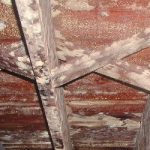With the hot weather the United States has been experiencing of late, a common  problem is beginning to occur. Damp crawl spaces are causing structural problems, as well as health problems, in a lot of houses due to the constant use of air conditioning systems during the hot summer days.
problem is beginning to occur. Damp crawl spaces are causing structural problems, as well as health problems, in a lot of houses due to the constant use of air conditioning systems during the hot summer days.
Cause of Damp Crawl Spaces
Moisture enters as a liquid, or as water vapor, through the soil under the crawl space and through the foundation walls. Liquid water travels through by gravity and by capillary action. Capillary action is water rising through a medium like soil, masonry materials, or wood because of the “clingyness” (surface tension) of water. Both water vapor and air travel through porous soil. Water vapor is lighter than air and rises more readily through the soil than does air. So if you have moisture underneath the crawl space, it has entered the crawl space in these ways.
- Hydraulic pressure from saturated soil can push water through foundation walls or under them.
- The water vapor can rise to the surface and join the air in the crawl space making that air more humid.
- Warm moist ventilation air brings water vapor into the crawl space, where the water vapor condenses.
- Liquid water can rise by capillary action and wet the surface dirt or evaporate into the crawl space air.
- Plumbing leaks can wet the crawl space.
Ground Water is a Problem
Most of the troublesome moisture comes from the ground around the home. This ground moisture is the cause of many, if not most, of a building’s moisture problems. If you cover a one-foot square of ground with plastic, and come back the next day and look at the plastic you will most likely see that the plastic is wet on its underside. That moisture is moisture rising through the soil.
How Damp Crawl Spaces Occur
Water vapor isn’t much of a problem as long as it doesn’t condense into liquid water. This summer has been hot, and the high-temperature air can evaporate a lot of water and hold a great deal of water vapor. That outdoor air ventilates the crawl space through vents and is cooled by the floor joists, which are cooled by the air conditioner, which is running constantly in the heat. The warm moisture laden air from outdoors moves next to the floor joist, which cools the air reducing its ability to hold the water vapor. The water vapor condenses on the floor joist and drips into puddles on the crawl space floor.
This moisture on the crawl space floor promotes mold, and moisture on the floor joists attracts mildew and causes rotting of the wood in the joists. This mold and mildew can aggravate the breathing of the building’s occupants, causing such chronic conditions as asthma and allergies.
Moisture on the joists, over time, cause the wood to rot which degrades the structural integrity of your home and can lead to very costly repairs.
Be aware of the possible dangers of running your air conditioner for extended periods during the hot summer days. Steps can be taken to mitigate the moisture that collects in your crawlspace. You can find out more about this problem, and how to prevent it, in our book Residential Energy: Cost Savings and Comfort for Existing Buildings.
